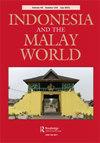调解丑恶
IF 0.9
3区 社会学
0 ASIAN STUDIES
引用次数: 0
摘要
摘要:本文探讨了印尼马来世界产生的五本《人类最优秀的诞生》手稿。这五份手稿都包括在先知诞辰纪念日和其他吉祥场合朗诵的这首著名且广受欢迎的panegyric的阿拉伯语文本,字里行间写着马来语或爪哇语的阿拉伯语翻译。18世纪末至19世纪末,每一份手稿都刻在不同的地点:一份来自亚齐,另一份来自殖民地锡兰(今斯里兰卡)的所谓“马来”侨民,第三份来自今天泰国南部的帕塔尼,第四份在麦加复制。这四种语言包括阿拉伯语到马来语的语际翻译。第五份手稿来自爪哇,有爪哇语翻译。通过仔细阅读阿拉伯语Maulid及其翻译的一个叙事部分,并将其与白话文进行比较,本文初步探讨了该地区广泛但研究较少的语际翻译领域中的标准化、创造性和文化特殊性问题。本文章由计算机程序翻译,如有差异,请以英文原文为准。
Mediating the maulid
ABSTRACT The article explores five Maulid Syaraf al-Anām (‘The birth of the best of mankind’) manuscripts produced in the Indonesian-Malay world. The five manuscripts all include the Arabic text of this well known and highly popular panegyric recited on the anniversary of the Prophet’s birthday as well as on other auspicious occasions, with the Arabic translation into either Malay or Javanese written between the lines. Each manuscript was inscribed at a different site between the late 18th and late 19th centuries: one is from Aceh, another from the so-called ‘Malay’ diaspora in colonial Ceylon (present-day Sri Lanka), a third from Patani, in today’s southern Thailand, while a fourth was copied in Mecca. These four include interlinear translations of the Arabic into Malay. The fifth manuscript, from Java, has a Javanese translation. Through a close reading of one narrative section of the Arabic Maulid and its translations, and their comparison with a vernacular telling, the article engages in a preliminary manner with questions of standardisation, creativity and cultural particularity within the wide, yet little-studied realm of interlinear translations from the region.
求助全文
通过发布文献求助,成功后即可免费获取论文全文。
去求助
来源期刊

Indonesia and the Malay World
ASIAN STUDIES-
CiteScore
2.00
自引率
0.00%
发文量
17
期刊介绍:
Indonesia and the Malay World is a peer-reviewed journal that is committed to the publication of scholarship in the arts and humanities on maritime Southeast Asia. It particularly focuses on the study of the languages, literatures, art, archaeology, history, religion, anthropology, performing arts, cinema and tourism of the region. In addition to welcoming individual articles, it also publishes special issues focusing on a particular theme or region. The journal is published three times a year, in March, July, and November.
 求助内容:
求助内容: 应助结果提醒方式:
应助结果提醒方式:


